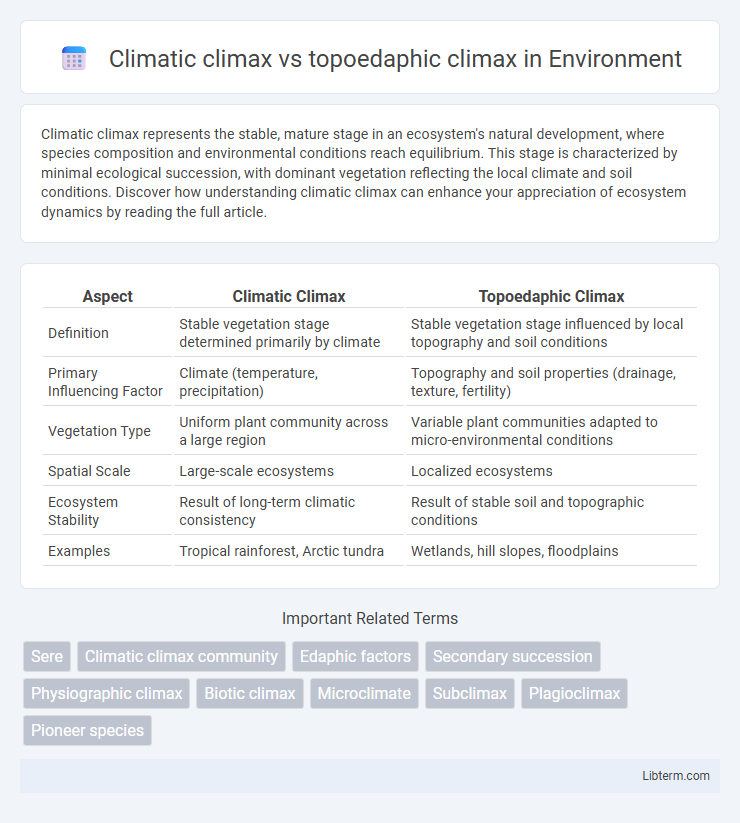Climatic climax represents the stable, mature stage in an ecosystem's natural development, where species composition and environmental conditions reach equilibrium. This stage is characterized by minimal ecological succession, with dominant vegetation reflecting the local climate and soil conditions. Discover how understanding climatic climax can enhance your appreciation of ecosystem dynamics by reading the full article.
Table of Comparison
| Aspect | Climatic Climax | Topoedaphic Climax |
|---|---|---|
| Definition | Stable vegetation stage determined primarily by climate | Stable vegetation stage influenced by local topography and soil conditions |
| Primary Influencing Factor | Climate (temperature, precipitation) | Topography and soil properties (drainage, texture, fertility) |
| Vegetation Type | Uniform plant community across a large region | Variable plant communities adapted to micro-environmental conditions |
| Spatial Scale | Large-scale ecosystems | Localized ecosystems |
| Ecosystem Stability | Result of long-term climatic consistency | Result of stable soil and topographic conditions |
| Examples | Tropical rainforest, Arctic tundra | Wetlands, hill slopes, floodplains |
Introduction to Ecological Climaxes
Ecological climaxes represent stable communities that arise from specific environmental conditions over time. Climatic climax is determined primarily by regional climate factors such as temperature and precipitation, resulting in vegetation that reflects these broad climatic patterns. In contrast, topoedaphic climax depends on local topography and soil characteristics, leading to vegetation that varies within smaller spatial scales despite similar climatic influences.
Defining Climatic Climax Communities
Climatic climax communities represent stable ecosystems primarily determined by regional climate conditions, where vegetation has reached a state of equilibrium with local temperature, precipitation, and seasonal patterns. These communities exhibit consistent species composition and structure that persist over time unless disrupted by external forces. Unlike topoedaphic climax communities, which are shaped by local soil and topography variations, climatic climax reflects broader climatic influences governing long-term ecological succession.
Understanding Topoedaphic Climax (Edaphic Climax)
Topoedaphic climax, also known as edaphic climax, refers to a stable plant community shaped primarily by soil and topographic conditions rather than climate. Unlike climatic climax communities driven by regional climate factors, topoedaphic climax vegetation reflects local variations in soil texture, moisture, pH, and nutrient availability. These site-specific edaphic factors result in unique ecological assemblages that can persist despite broader climatic influences.
Key Differences Between Climatic and Topoedaphic Climax
Climatic climax refers to a stable ecological community shaped primarily by the prevailing regional climate, with vegetation that reflects long-term climate conditions. In contrast, topoedaphic climax depends on local topography, soil characteristics, and micro-environmental factors, causing variations in plant communities even within the same climatic region. Key differences include the broader climatic influence on climatic climax versus the localized soil and terrain-driven factors defining topoedaphic climax, resulting in different succession endpoints and biodiversity patterns.
Factors Influencing Climatic Climax
Climatic climax ecosystems develop under stable climate conditions where temperature, precipitation, and seasonal patterns dictate vegetation types and soil formation over time. Key factors influencing climatic climax include long-term climate stability, regional temperature ranges, and consistent moisture availability, which shape plant succession and biodiversity. Unlike topoedaphic climax, which depends on local topography and soil characteristics, climatic climax emphasizes broader atmospheric and environmental controls on ecological equilibrium.
Role of Topography and Soil in Topoedaphic Climax
Topographic features such as slope, aspect, and elevation create microclimates that influence vegetation patterns in a topoedaphic climax, distinguishing it from the broader climatic climax determined primarily by regional climate. Soil properties, including texture, drainage, nutrient availability, and depth, interact with these topographic factors to control species composition, productivity, and succession trajectories. Together, topography and soil conditions establish stable, site-specific climax communities that reflect localized environmental constraints rather than general climatic influences.
Examples of Climatic Climax Ecosystems
Climatic climax ecosystems develop under stable climate conditions, such as tropical rainforests in the Amazon Basin, where consistent high temperatures and yearly rainfall support dense, diverse vegetation. Temperate deciduous forests in the Eastern United States also represent climatic climax stages, characterized by seasonal temperature variations and moderate precipitation. These ecosystems contrast with topoedaphic climax communities, which form due to specific soil and topographic influences rather than regional climate, such as xeric oak woodlands on dry, rocky slopes.
Case Studies of Topoedaphic Climax Communities
Topoedaphic climax communities develop under the influence of local topography and soil conditions rather than the regional climate that drives climatic climax communities. Case studies from diverse ecosystems, such as the hardwood forests in the Appalachian region, illustrate how microtopography and soil moisture gradients create distinct climax vegetation differing significantly from the broader climatic climax expected. These localized factors promote specialized plant assemblages that maintain ecosystem stability despite variations in regional climate, emphasizing the importance of topoedaphic influences in ecological succession and vegetation patterns.
Ecological Significance and Applications
Climatic climax ecosystems represent the stable, mature community shaped primarily by regional climate, serving as a reference point for natural vegetation succession and biodiversity conservation. Topoedaphic climax communities develop under the influence of specific local soil and topographic conditions, highlighting the importance of microhabitat variability in ecosystem management and habitat restoration. Understanding both climax types enhances ecological modeling, guiding land use planning and sustainable resource management by aligning vegetation with environmental gradients.
Conclusion: Comparing and Contrasting the Two Climax Concepts
Climatic climax represents the stable vegetation community determined primarily by regional climate, while topoedaphic climax reflects localized climax conditions shaped by soil and topography. The key distinction lies in the scale and controlling factors: climatic climax is governed by broad climatic patterns, whereas topoedaphic climax varies with microenvironmental conditions such as soil type and drainage. Understanding both concepts is essential for accurate ecological succession analysis and effective land management strategies.
Climatic climax Infographic

 libterm.com
libterm.com